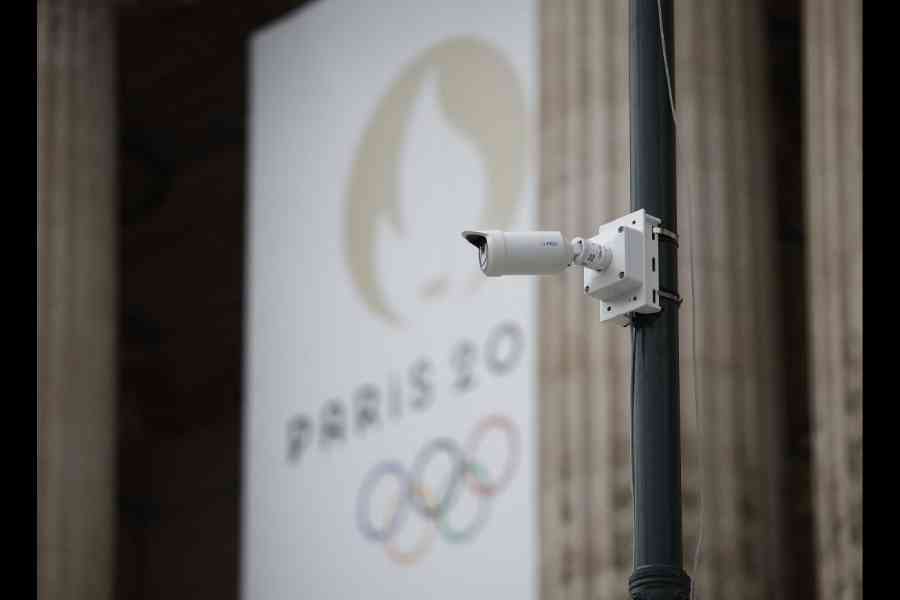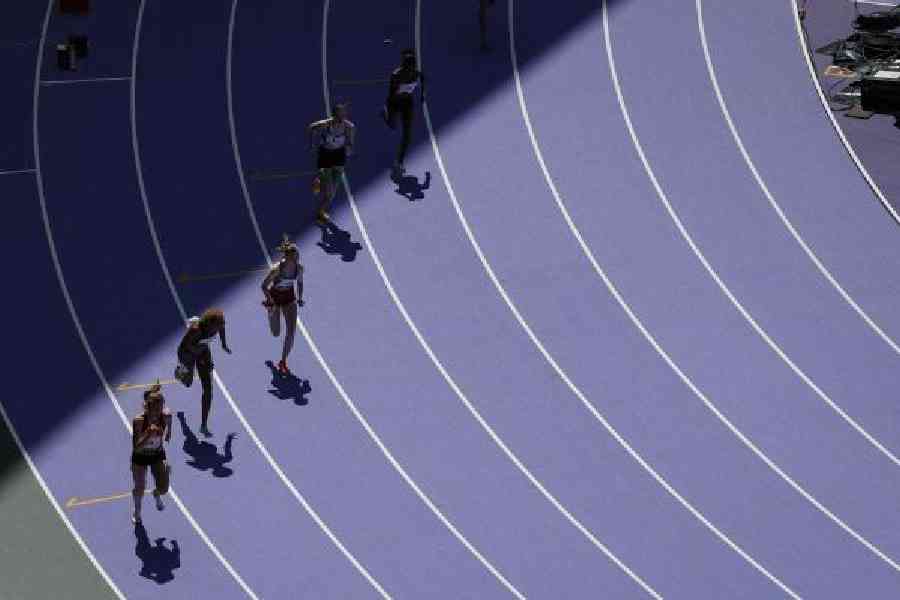The essence of the Olympic Games remains unchanged — a few weeks during which the world’s best athletes compete to move faster, higher and stronger. Technology continues to be a part of the way the Games unfold and it continues to inspire athletes. Here are some innovations that are being seen at the Paris Olympics 2024.
Purple run
Purple, which the Pantone Colour Institute once described as the “most complex of colours” because it blends the seemingly diametrically opposed — blue and red — to create something new, will greet athletes when they try to set records at the Paris Games. The move away from the traditional red-brick clay colour has been done because purple is one of the colours of the Games.

File picture of Omega's Scan-o-Vision
The pieces of vulcanised rubber track, produced at a factory in northern Italy, are glued and nailed to the track. Mondo is the company behind the 1,000 rolls of the material that is being used. What makes the tracks special is the packing of granules that are more elastic and cohesive while algorithms have helped create a more optimal shape and dimension for the air cells inside the track to reduce energy loss, resulting in better performance.
When Paris hosted the Games in 1924, the track inside the Stade Olympique Yves-du-Manoir was ash-grey cinder, like at the first modern version of the Games held in Athens in 1896. With the 1928 edition appeared the cinder track and then in 1968 came the red synthetic track.

Jenna Fryer of The Associated Press swims wearing a Speedo Fastskin LZR Pure Valor 2.0 that will be used by many swimmers at the 2024 Summer Olympics. Speedo allowed journalists to try what it claims is “the world’s fastest swimsuit”
Combating infrared voyeurism
When the Japanese women’s volleyball, athletics and table tennis teams appear, they will sport outfits made from a new fabric that can better absorb infrared light. The technology is on the lines of that used by stealth aircraft to avoid detection.
Developed by Japanese equipment manufacturer Mizuno, the fabric will prevent infrared photos from highlighting undergarments — and even bodies — of athletes.
Some devices have inadvertently showcased how infrared sensing can reveal the unseen, like the OnePlus 8 Pro from 2020. It had something called a “Photochrom” colour filter that worked like X-ray vision.

File picture of Hellen Obiri taking first place in the women’s Boston Marathon on April 15 wearing On’s LightSpray trainers
Kazuya Tajima, a member of Mizuno’s development team, hopes that “use of this fabric by top athletes will make society aware that voyeurism is unacceptable”. The decision to work on the fabric was taken by the equipment manufacturer at a time when “cameras are becoming increasingly sophisticated. The use of infrared for photographs reveals underwear and bodies under swimsuits and shorts”.
The fabric uses specialised material that absorbs light from the infrared range, making it “nearly wholly opaque” under both visible and infrared light.
AI cords
What does artificial intelligence sound like? Your favourite stars. TV viewers in the US will experience the power of AI-driven voice when NBC presents a version of famed sportscaster Al Michaels. The broadcaster has announced that Michaels’s voice will deliver daily recaps of the Summer Games for subscribers of its Peacock streaming platform.
Michaels, a long-time broadcaster, is at the moment a sportscaster for Thursday Night Football on Amazon Prime but he is known for his work on earlier Olympics Games broadcasts for both NBC and ABC and for calling the ‘Miracle on ice game’ at the 1980 Winter Olympics in Lake Placid, New York.
AI-generated voices have been in the spotlight since OpenAI revealed upgrades to its artificially intelligent chatbot earlier this year. ChatGPT “spoke” in a voice that sounded eerily like Scarlett Johansson in the 2013 Spike Jonze movie Her. The actor protested loudly and OpenAI did the same but at a lower decibel.
Smart cameras
Artificial intelligence (AI) for video surveillance is a controversial technology but given the scale of the event, it will be used to analyse live images to identify certain predefined movements and send an alert to operators. Smart cameras are being used for spotting forgotten luggage and crowd movements. According to Le Monde, in the Paris region, some “200 cameras in the Paris and Ile-de-France area will benefit from artificial assistance” during the summer.

A security camera at the Paris 2024 Olympics
Before putting the software to use, it had to be tried out. So the software for real-time analysis of video surveillance images was tested (as far as the law allows) at major cultural and sporting events, including concerts in the Paris region and even the French Open.
Starting blocks to finish line
Omega will have an important role to play… to be precise, its timekeeping team will be on their toes. In every sport, time plays a crucial role and even a fraction of a second matters. The electronic starting pistol is now connected to a speaker behind each athlete. Take the case of staggered-lane races, like the 400-metre, where athletes in the furthest lane may hear the gun a fraction later. Why put the person at a disadvantage? So this technology will help.
Technology will also be used when it comes to photo finishes. In the 1940s it took around two hours to come to a decision because footage had to be developed. Now Omega’s Scan-o-Vision can capture up to 40,000 digital images per second at the finish line, allowing judges to make a call in minutes.
‘Rocket’ suits
Taking a cue from technology that finds inspiration in space travel, Speedo has come up with a new version of its Fastskin LZR Racer suit, which is considered its most water-repellent ever. It claims to offer a sense of “weightlessness” and it will be worn by top swimmers including Emma McKeon from Australia, the American Caeleb Dressel and Britain’s Adam Peaty. The suits use a coating technology originally used to protect satellites. But it seems that it takes around 10 minutes to get into Fastskin LZR Intent and LZR Valor suits.

Al Michaels had a great view from the front of the balcony for the Lake Placid 1980 men’s ice hockey competition
Spray-on trainers
Hellen Obiri, the Kenyan long-distance runner, will wear the Cloudboom Strike LS, a design made by Swiss sneaker brand On, using what they call LightSpray technology that will be released to the public this autumn. To produce a shoe, a robotic arm holds a foot-shaped last as thermoplastic polyurethane is sprayed in a continuous string, giving way to a rubbery textile shoe. There are no laces but the shoes are designed to absorb impact. Bonded with heat rather than glue, the shoe is then coloured by inkjet printer.










